
Friday November 18, 2022
By Marquise Francis and Giles Clarke

Nuurto Ali Issaq, a single mother of five, lives in the Ladan site for internally displaced people in the Doolow district in Somalia. The site is home to the newly drought-displaced families from neighboring regions like Bay and Bakool, epicenters of the deteriorating drought situation. (Giles Clarke)
DOOLOW, Somalia — Before the start of the worst drought Somalia has experienced in four decades, 30-year-old Nuurto Ali Issaq tended to 40 goats and other livestock as a pastoralist, having just enough resources to make a living and feed herself and her five children. But less than three years later, with the East African country in the midst of its fifth consecutive failed rainy season, all of Issaq’s animals have died due to dehydration, leaving her family in the same predicament as nearly half of the country’s 16 million people — starving, poor and nowhere to turn.
“When my last goat died a year ago, I lost hope,” Issaq said.
This summer, as violence plagued the region, Issaq traveled by foot more than 200 miles over 10 days with her children in a donkey cart from her rural village to the town of Baidoa and then to the Doolow district, seeking out an urban center in hopes of any kind of relief. Often, she said, she and her children would walk upwards of 12 hours a day without food or water, begging for sustenance in any village they came across.
“This journey to Doolow was our last hope,” she said.
As harrowing as Issaq’s story is, it has become almost commonplace in all parts of the country, as about 8 million people across Somalia experience high levels of acute food insecurity, which means they are in dire need of food assistance. Four consecutive failed rainy seasons have given way to barren harvests, depleting livestock and such thinning resources across the country that more than 1 million Somalis have been forced to leave their homes in search of safety, food and water.
Across the sub-Saharan region, most people rely on agriculture for survival as fishermen, herders and farmers. Without a harvest, neither people nor animals can survive unless outside assistance is provided. Resource scarcity has only been compounded by the economic impact of COVID-19 and the rising costs due to Russia’s war in Ukraine, a country known as “Europe’s breadbasket,” from which Somalia imports 90% of its wheat. If these conditions remain, 1 out of every 5 children in the country faces death from malnutrition. Experts say the current outlook of future failed rainy seasons is building up to be an unrivaled humanitarian crisis.
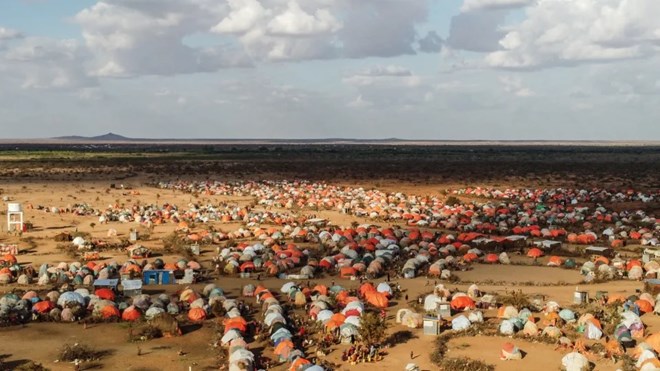
The sprawling Ladan IDP settlement near Doolow in southeastern Somalia. According to the United Nations High Commissioner for Refugees, there were around 16,000 who moved to the area following a 2011 famine. As of October, over 180,000 people were living in displacement sites around Doolow. (Giles Clarke)
“Right now, it’s the livestock [at risk], and next it’s going to be our children,” Margret Mueller, regional coordinator for East and Central Africa of Oxfam International, a global organization that focuses on the alleviation of poverty, told Yahoo News in October.
Internally displaced persons, or IDPs, within Somalia like Issaq and her family have traveled through dangerous terrain and conflict-ridden communities in hopes of reaching a camp for some sort of refuge. But too often most camps are overwhelmed and under-resourced. Other Somalis have resorted to rationing their own food to feed children and livestock, some going days without anything at all.
Baar Omar, a 42-year-old mother of 10 who lives in a small village 15 miles outside Doolow near Ethiopia, has had her livelihood as a herder ravaged in the last few years. In 2018, Omar had upwards of 250 goats and 20 cows. Today she has just a third of each left.
“The drought has taken most of our livestock, and the remaining ones are weak and cannot survive,” said Omar, who recently found out that a water truck delivery system her family depended on was ending because of a lack of funding.
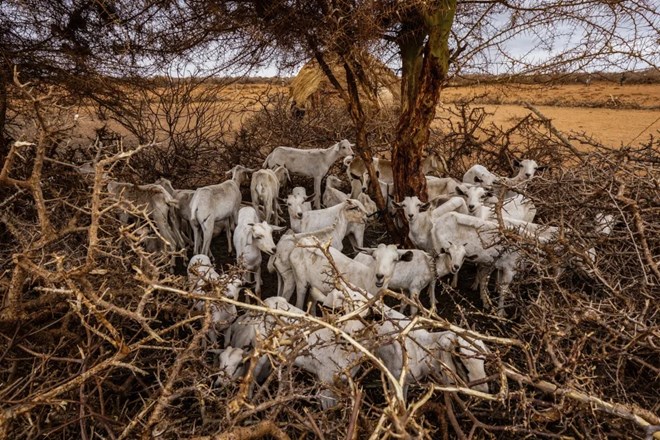
Goats in a spiky pen at a rural dwelling outside Doolow. As the two-and-a-half-year drought drags on, when the livestock are so weakened due to less food and water, the herders often keep the animals in these thorny pens to protect them from theft and against roaming hyenas at night. (Giles Clarke)
“If the water trucking stops, we must go to the Jubba River, which is 13 kilometers [8 miles] away. The donkeys are now too weak to transport water that far, so without the deliveries we are finished,” she said. “All I know is life as a herder, where we look after our livestock to make our living. Without water, we die.”
Tales of despair continue to pile up. A severely malnourished child is admitted to a health facility every minute of every day in Somalia. Babies are so weak that they can no longer cry. Hunger is likely to lead to one death every 36 seconds. One woman was so debilitated from hunger that she could not bury her child.
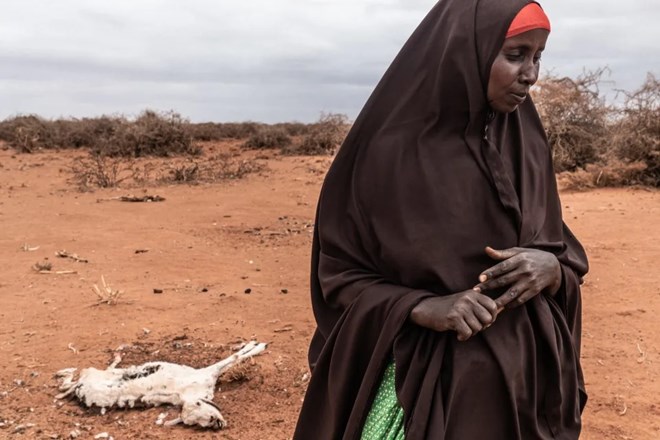
Baar Omar stands by one of her dead goats on scorched land in a small village 15 miles outside Doolow. (Giles Clarke)
But a famine has yet to be declared because the Somali government fears a domino effect would further hinder the region, according to a New York Times report.
A famine is a rare and specific declaration made by the United Nations and national governments, according to the Integrated Food Security Phase Classification (IPC), a tool for improving food security analysis and decision making. The designation is made when at least 20% of households are facing an extreme lack of food, about 30% of children are suffering from acute malnutrition and 2 people out of every 10,000 are dying each day due to outright starvation or the interaction of malnutrition and disease.
Such a declaration, officials worry, would mean that millions would flee affected areas into major cities and towns, only further exacerbating already low resources and possibly leading to a spike in crime. The government also fears that a declaration of famine would potentially deter future investors and instead shift the focus toward aid money instead of funding health care programs and education.
Regardless, humanitarian leaders say history has proved that any declaration will likely be too late. A 2011 famine in Somalia claimed the lives of 260,000 people, more than half of them children under the age of 6. By the time a famine was declared, more than 120,000 people had already died. Many critics fear a repeat a decade later.
“A famine designation will be too late — people are already dying,” David Miliband, president and CEO of the International Rescue Committee, said in a statement. “During the last famine in Somalia in 2011, half of all deaths occurred before famine was declared. … The international community pledged to ‘never again’ allow famine in Somalia or wait so long to act, but it is repeating the same mistake this year.”

A child is measured for malnutrition in the Outpatient Therapeutic Program area of a UNICEF/USAID-supported health facility in Doolow. (Giles Clarke)
Despite the despair, many people are unaware the crisis even exists. A poll from September of Americans ages 19 to 34 conducted by the IRC and YouGov found that 69% did not know there was a drought in East Africa until they took the survey. Another 57% said politicians are not doing enough to address climate change and related food shortages.
The U.S. has so far donated over $2 billion in critical humanitarian assistance across the Horn of Africa to affected regions, including Somalia, more than the rest of the world combined, according to a spokesperson for the U.S. Agency for International Development (USAID). But a gap of $1 billion remains, according to the U.N.
And while Somalia is in trouble, the surrounding countries of Djibouti, Eritrea and Ethiopia, which together make up the Horn of Africa, show significant signs that the challenges are only just beginning.
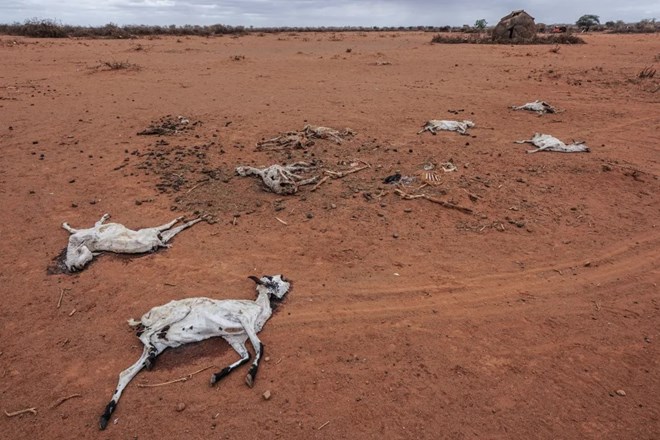
Goat carcasses strewn over the parched scrubland in the Gedo region of Somalia. According to the Famine Early Warning Systems Network and other food security organizations monitoring the Horn of Africa region, some 7 million animals have been lost during the recent and unprecedented drought. When the animals die, they are often dragged away from the rest of the herd to distract wandering hyenas, particularly at night, and prevent the spread of disease. (Giles Clarke)
“While there is an appropriately extreme concern for the Bay Region of Somalia, and the focus is on Somalia right now, the scale of need is significant across the Horn of Africa,” Vanessa Roy, deputy chief of party for analysis at the Famine Early Warning Systems Network, told Agrilinks, an online community for food security and agricultural development practitioners. “We don’t want to lose sight of the widespread need across the wider Horn of Africa because there are high levels of acute malnutrition and hunger-related mortality in Ethiopia and Kenya as well, and those needs also warrant a massive scale-up of assistance.”
Abby Maxman, president of Oxfam America, said that “in a world of plenty” it’s unacceptable for people to starve.
“It’s shameful that people are on the brink of famine anywhere,” she said. “It is shameful and unacceptable and preventable.”
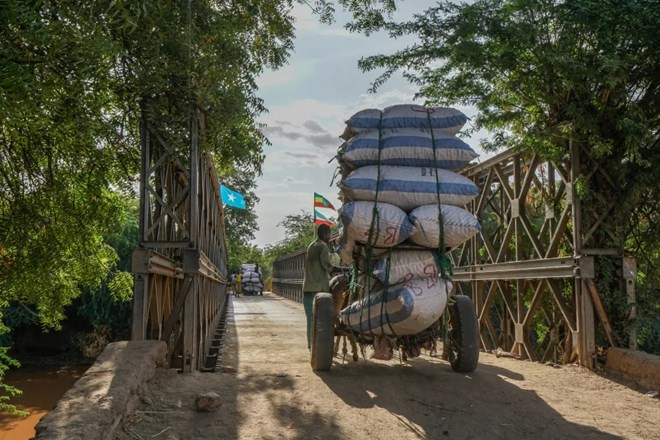
The Somali-Ethiopian border bridge provides 24-hour access between the IDP and refugee settlements in the Doolow region of Somalia and Ethiopia. The bridge crosses the Jubba River, which snakes its way from the highlands of Ethiopia to the Somali coast into the Indian Ocean. (Giles Clarke)